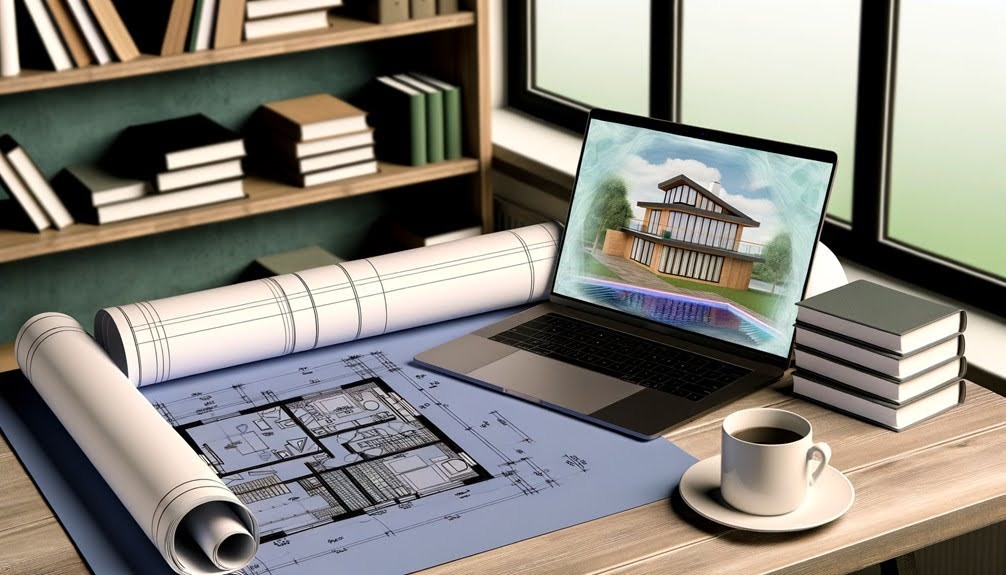You might think planning your dream home is overwhelming, but breaking it down into manageable steps can simplify the process. By clearly defining your vision and setting a realistic budget, you can transform your ideas into a tangible plan. Choosing the right location is also essential, as it lays the foundation for your future happiness. But what comes next? Understanding how to design a functional layout and select quality materials can make all the difference – especially when partnering with experienced full suite home remodelers who can guide you through each step with expertise.
Define Your Vision

Defining your vision is the foundational step in planning your dream home, as it sets the tone for every decision that follows.
Begin by envisioning how you want your space to feel and function. Picture the lifestyle you aspire to live-whether it’s a cozy retreat for relaxation or a vibrant hub for entertaining family and friends.
Next, explore the specifics. Consider the architectural style that resonates with you, be it modern, rustic, or traditional.
Think about the layout that best serves your needs-open-concept spaces for socializing or defined rooms for privacy.
Don’t forget to explore the elements that bring you joy, such as natural light, outdoor views, or unique materials.
Create a mood board with images, colors, and textures that inspire you. This visual representation will serve as a guiding star throughout the design process.
Set a Realistic Budget
Setting a realistic budget is essential for turning your dream home vision into a tangible reality. Without a clear financial plan, it’s easy to overspend or compromise on key features.
Follow these steps to develop a budget that aligns with your dreams:
- Assess Your Finances: Analyze your income, savings, and any existing debts. This will give you a clear picture of how much you can allocate for your home project.
- Research Costs: Investigate the costs associated with home building or renovation, including materials, labor, permits, and inspections. Gathering quotes from contractors can help you gauge realistic prices.
- Prioritize Your Needs: Determine which features are non-negotiable and which can be adjusted. This will guarantee you’re not overspending on luxuries when your budget is tight.
- Include a Contingency Fund: Set aside at least 10-15% of your total budget for unexpected expenses. This buffer can save you from financial strain should unforeseen issues arise.
Choose a Location

Choosing the right location for your dream home is fundamental, as it shapes not only your living experience but also your long-term investment.
Begin by identifying your priorities: proximity to work, schools, public transportation, and recreational areas. Each factor plays a significant role in your daily life and future resale value.
Next, research neighborhoods. Visit them at various times, noting traffic patterns, noise levels, and community dynamics. Engage with locals to gain insights about safety and amenities.
Don’t overlook the importance of local infrastructure-check for future development plans that could enhance or detract from the area.
Consider the land itself. Evaluate the topography, soil quality, and potential environmental hazards. Access to utilities like water, electricity, and sewage systems is essential.
If you’re eyeing rural land, assess the availability of resources and emergency services.
Design Your Layout
Once you’ve settled on the perfect location, it’s time to visualize how your dream home will come together. Designing your layout is essential, as it dictates the flow and functionality of your space.
Start by considering the lifestyle you want to live. Imagine how each area will interact with the others.
- Open Concept Living: Combine your kitchen, dining, and living spaces to encourage interaction and maximize natural light.
- Zoning: Create designated zones for relaxation, work, and entertainment this helps in organizing the home effectively.
- Room Size and Proportions: Think about the size of each room. Guarantee bedrooms provide comfort, while the kitchen supports your cooking needs without feeling cramped.
- Outdoor Integration: Incorporate outdoor spaces like patios or decks. Consider how these areas will connect with your indoor spaces for seamless changes.
Select Materials and Finishes

As you immerse yourself in selecting materials and finishes for your dream home, keep in mind that every choice impacts both the aesthetics and functionality of your space.
Start by considering the core materials-think about the durability and maintenance of flooring, countertops, and cabinetry. For flooring, hardwood offers warmth, while tiles provide versatility and easy cleaning.
Next, explore countertops granite and quartz are popular for their resilience and variety.
When it comes to cabinetry, select finishes that align with your overall design theme, whether you prefer sleek modern lines or rustic charm.
Don’t overlook finishes, like paint and hardware. Choose paint colors that not only enhance the light in your rooms but also reflect your personal style.
Hardware, like knobs and faucets, can either complement or contrast your material choices, adding an extra layer of design cohesion.
Find the Right Builder
Finding the right builder is essential to bringing your dream home to life. A skilled builder not only translates your vision into reality but also guarantees quality and adherence to your timeline.
To choose wisely, consider the following factors:
- Experience and Reputation: Look for builders with a proven track record in your area. Check online reviews and ask for references to gauge their reliability.
- Specialization: Confirm the builder specializes in the type of home you want-whether it’s contemporary, traditional, or eco-friendly. Each style requires different expertise.
- Communication: A builder should be approachable and open to discussions. Their ability to communicate effectively can greatly impact the overall process.
- Budget Alignment: Discuss your budget openly. A competent builder will provide a detailed estimate that aligns with your financial plan while also suggesting cost-effective alternatives.
Navigate Permits and Regulations

Steering through permits and regulations is vital for guaranteeing your dream home project progresses smoothly and legally. Before you break ground, familiarize yourself with local zoning laws, building codes, and permit requirements. Every municipality has its own set of rules, so research thoroughly or consult a local expert to avoid costly setbacks.
Start by obtaining a land use permit, which guarantees your property is zoned for residential construction. Next, you’ll need a building permit this typically involves submitting detailed plans that outline your home’s design, structural integrity, and safety features. Each document must meet specific criteria laid out by your local building department, so precision is key.
Don’t forget to check for additional permits related to plumbing, electrical work, or landscaping, as these can vary greatly. Some areas may also require environmental assessments, especially if your lot is in a sensitive zone.
Keep organized records of all your applications and correspondence with officials. This documentation not only helps track your progress but can also be invaluable if any disputes arise during construction.
Maneuvering through this maze can feel overwhelming, but it’s a vital step toward realizing your dream home.
Conclusion
In the grand tapestry of creating your dream home, each thread weaves a narrative of ambition and care. By envisioning your perfect space, budgeting wisely, and selecting the right location, you lay a strong foundation. Thoughtful design and quality materials enhance the experience, while a skilled builder transforms your aspirations into reality. As you navigate the complexities of permits, remember: every challenge is merely a stepping stone toward the sanctuary you’ve always dreamed of calling home.

